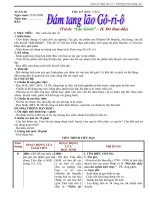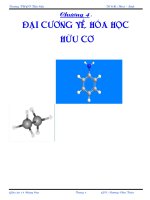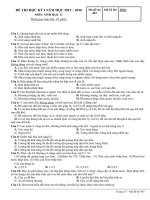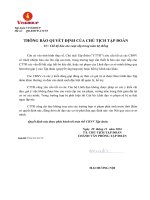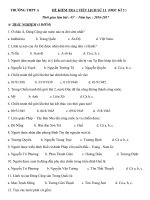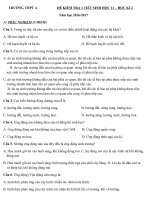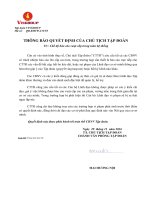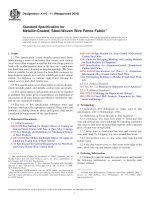Astm a 660 a 660m 11 (2016)
Bạn đang xem bản rút gọn của tài liệu. Xem và tải ngay bản đầy đủ của tài liệu tại đây (94 KB, 4 trang )
Designation: A660/A660M − 11 (Reapproved 2016)
Standard Specification for
Centrifugally Cast Carbon Steel Pipe for High-Temperature
Service1
This standard is issued under the fixed designation A660/A660M; the number immediately following the designation indicates the year
of original adoption or, in the case of revision, the year of last revision. A number in parentheses indicates the year of last reapproval.
A superscript epsilon (´) indicates an editorial change since the last revision or reapproval.
ing (Withdrawn 2000)4
E186 Reference Radiographs for Heavy-Walled (2 to 41⁄2 in.
(50.8 to 114 mm)) Steel Castings
E381 Method of Macroetch Testing Steel Bars, Billets,
Blooms, and Forgings
E446 Reference Radiographs for Steel Castings Up to 2 in.
(50.8 mm) in Thickness
2.2 ANSI Standards:
B36.10 American Standard for Welded and Seamless
Wrought Steel Pipe5
B46.1 Surface Texture5
2.3 MSS Standards:
SP-54 Quality Standard for Steel Castings for Valves,
Flanges, and Fittings and Other Piping Components Radiographic Examination Method6
1. Scope*
1.1 This specification2 covers carbon steel pipe made by the
centrifugal casting process intended for use in hightemperature, high-pressure service. Pipe ordered under this
specification shall be suitable for fusion welding, bending, and
other forming operations.
1.2 Several grades of carbon steels are covered. Their
compositions are given in Table 1.
1.3 Supplementary requirements (S1 to S9) of an optional
nature are provided. The supplementary requirements call for
additional tests to be made, and when desired shall be so stated
in the order, together with the number of such tests required.
1.4 The values stated in either inch-pound units or SI units
are to be regarded separately as standard. Within the text, the
SI units are shown in brackets. The values stated in each
system are not exact equivalents; therefore, each system must
be used independently of each other. Combining values from
the two systems may result in nonconformance with the
specification.
3. Ordering Information
3.1 Orders for material under this specification should
include the following, as required, to describe the desired
material adequately:
3.1.1 Quantity (feet, metres, or number of lengths),
3.1.2 Name of material (centrifugally cast pipe),
3.1.3 Grade (Table 1),
3.1.4 Size (outside or inside diameter and minimum wall
thickness),
3.1.5 Length (specific or random), (Permissible Variations
in Length Section of Specification A530/A530M),
3.1.6 End finish (Ends Section of Specification A530/
A530M),
3.1.7 Optional Requirements (Sections 7.2, 8.2, 8.3, 11.1,
Section 12 and S1 to S9 (Supplementary Requirements),
3.1.8 Test report required (Certification Section of Specification A530/A530M),
3.1.9 Specification designation, and
3.1.10 Special requirements.
2. Referenced Documents
2.1 ASTM Standards:3
A530/A530M Specification for General Requirements for
Specialized Carbon and Alloy Steel Pipe
E94 Guide for Radiographic Examination
E114 Practice for Ultrasonic Pulse-Echo Straight-Beam
Contact Testing
E125 Reference Photographs for Magnetic Particle Indications on Ferrous Castings
E142 Method for Controlling Quality of Radiographic Test1
This specification is under the jurisdiction of ASTM Committee A01 on Steel,
Stainless Steel and Related Alloys and is the direct responsibility of Subcommittee
A01.18 on Castings.
Current edition approved Sept. 1, 2016. Published September 2016. Originally
approved in 1972. Last previous edition approved in 2011 as A660/A660M – 11.
DOI: 10.1520/A0660_A0660M-11R16.
2
For ASME Boiler and Vessel Code applications see related Specification
SA-660 in Section II of that Code.
3
For referenced ASTM standards, visit the ASTM website, www.astm.org, or
contact ASTM Customer Service at For Annual Book of ASTM
Standards volume information, refer to the standard’s Document Summary page on
the ASTM website.
4
The last approved version of this historical standard is referenced on
www.astm.org.
5
Available from American National Standards Institute (ANSI), 25 W. 43rd St.,
4th Floor, New York, NY 10036, .
6
Available from Manufacturers Standardization Society of the Valve and Fittings
Industry (MSS), 127 Park St., NE, Vienna, VA 22180-4602, .
*A Summary of Changes section appears at the end of this standard
Copyright © ASTM International, 100 Barr Harbor Drive, PO Box C700, West Conshohocken, PA 19428-2959. United States
1
A660/A660M − 11 (2016)
TABLE 1 Chemical Requirements
TABLE 2 Tensile Requirements
Composition, max,%
Carbon
Manganese
Phosphorus
Sulfur
Silicon
Grade WCA
Grade WCB
Grade WCC
0.25A
0.70A
0.035
0.035
0.60
0.30
1.00
0.035
0.035
0.60
0.25B
1.20B
0.035
0.035
0.60
Tensile strength, min
Yield strength, min
Elongation in 2 in. or 50
mm, min, %
Reduction of area, min,
%
A
For each reduction of 0.01 % below the specified maximum carbon content, an
increase of 0.04 % manganese above the specified maximum will be permitted up
to a maximum of 1.10 %.
B
For each reduction of 0.01 % below the specified maximum carbon content, an
increase of 0.04 % manganese above the specified maximum will be permitted to
a maximum of 1.40 %.
ksi
WCA
MPa
ksi
WCB
MPa
ksi
WCC
MPa
60
30
415
210
70
36
485
250
70
40
485
275
24
22
22
35
35
35
8.1.2 Transverse or Longitudinal Tension Test—One test
shall be made on a specimen from one end of one length of
pipe representing each heat in each heat-treatment lot.
8.2 Flattening Test:
8.2.1 A flattening test shall be performed when requested by
the purchaser or when stated by the purchaser on the order that
the pipe is to be upset, swaged, expanded, bent, or formed by
some other operation.
8.2.2 A flattening test need not be performed on heavy wall
pipe which is not to be upset, swaged, expanded, bent, or
formed in some other manner.
8.2.3 When required by 8.2, a test shall be made on
specimens cut from one end of each length of pipe.
8.2.4 A flattening test when required shall be performed in
accordance with the requirements for seamless and centrifugally cast pipe in the Flattening Test Requirements Section of
Specification A530/A530M.
4. General Requirements
4.1 Material furnished under this specification shall conform to the applicable requirements of the current edition of
Specification A530/A530M unless otherwise provided herein.
5. Materials and Manufacture
5.1 Machining:
5.1.1 All centrifugally cast pipe shall have both the inner
and outer surfaces machined.
5.1.2 After heat treatment, the pipe shall be machined to a
finish with a roughness value no greater than 250 µin. [6.35
µm] arithmetical average deviation (AA), terms as defined in
ANSI B46.1 unless otherwise specified.
NOTE 1—In heavy-walled small-diameter tubing the flattening test
specimen may be bored out so that the OD/t ratio will be greater than 11.0.
5.2 Heat Treatment:
5.2.1 All pipe shall receive a heat treatment proper for its
design and chemical composition.
5.2.2 Castings shall be heat treated after they have been
allowed to cool below the transformation range.
8.3 Hydrostatic Test:
8.3.1 Each length of pipe shall be hydrostatically tested in
accordance with the Hydrostatic Test Requirements Section of
Specification A530/A530M when requested by the purchaser
and stated on the order. If performance of the hydrostatic test
is not required by the purchaser, the manufacturer shall
guarantee pipe to pass the test and mark each length of pipe
with the letters “NH” immediately following the specification
number, indicating that the pipe has not been hydrostatically
tested.
8.3.2 When required by 8.3, each length of pipe shall be
subjected to the hydrostatic test. The test pressure shall be
maintained for not less than 5 min.
6. Temperature Control
6.1 Furnace temperatures for heat treating shall be effectively controlled by pyrometers.
7. Chemical Requirements
7.1 The steel shall conform to the requirements as to
chemical composition prescribed in Table 1.
9. Permissible Variation in Wall Thickness
7.2 Product Analysis:
7.2.1 At the request of the purchaser, a product analysis
shall be made by the manufacturer on every heat.
7.2.2 The results of these analyses shall be reported to the
purchaser or his representative, and shall conform to the
requirements specified in Table 1.
7.2.3 If the analysis of one of the tests specified in 7.2.1
does not conform to the requirements specified, an analysis of
each pipe from the same heat may be made, and all pipes
conforming to the requirements shall be accepted.
9.1 The wall thickness shall not vary over the specified
minimum wall thickness by more than 10 %. There shall be no
variation under the specified minimum wall thickness.
NOTE 2—A system of standard pipe sizes has been approved by the
American National Standards Institute, as ANSI B36.10. This system may
be used for obtaining pipe under this specification.
10. Workmanship and Finish
10.1 The pipe shall have a finish as provided in 5.2 and it
shall be reasonably straight and free from injurious defects.
8. Mechanical Requirements
11. Rework and Retreatment
8.1 Tensile Properties:
8.1.1 The material shall conform to the requirements as to
tensile properties prescribed in Table 2.
11.1 Imperfections—The surface of the casting shall be
inspected visually for cracks and hot tears. These imperfections
2
A660/A660M − 11 (2016)
following welding and retreating shall be considered as meeting the requirements of 5.1.
shall be removed, and their removal verified by visual inspection of the resultant cavities. Imperfections located by inspecting with Supplementary Requirements S7, S8, or S9 shall be
removed or reduced to an acceptable size.
12. Product Marking
11.2 Blending—If removal of the imperfection does not
infringe upon the minimum wall thickness, the depression may
be blended uniformly into the surrounding surface.
12.1 In addition to the marking prescribed in Specification
A530/A530M, the marking shall include the wall thickness,
piece mark, length and additional symbol “S” if the pipe
conforms to one or more of the supplementary requirements
specified in S1 to S9, and the heat number or manufacturer’s
number by which the heat can be identified. Identification
stamping instead of stenciling will be permitted only with the
written approval of the purchaser.
11.3 Repair by Welding—Imperfections that infringe upon
the minimum wall thickness may be repaired by welding
subject to approval by the purchaser. Only qualified operators
and procedures in accordance with ASME Boiler and Pressure
Vessel Code, Section IX, shall be used. All weld repairs shall
be inspected to the same quality standards used to inspect the
pipe.
12.2 Bar Coding—In addition to the requirements in 12.1,
bar coding is acceptable as a supplemental identification
method. The purchaser may specifiy in the order a specific bar
coding system to be used.
11.4 Reheat Treatment—Local or full heat treatment in
accordance with 5.2 shall follow welding. Local grinding
SUPPLEMENTARY REQUIREMENTS
One or more of the following supplementary requirements shall apply only when specified in the
purchase order. The purchaser may specify a different frequency of test or analysis than is provided
in the supplementary requirement. Subject to agreement between the purchaser and manufacturer,
retest and retreatment provisions of these supplementary requirements may also be modified.
from one end or both ends of each pipe and shall show sound
and reasonably uniform material free from injurious
laminations, cracks, and similar objectionable defects. If this
supplementary requirement is specified, the number of tests per
pipe required shall also be specified. If a specimen from any
length shows objectionable defects, the length shall be rejected,
subject to removal of the defective end and subsequent retests
indicating the remainder of the length to be sound and
reasonably uniform material.
S1. Product Analysis
S1.1 Product analysis shall be made on each length of pipe.
Individual lengths failing to conform to the chemical composition requirements shall be rejected.
S2.
Additional Tension Tests
S2.1 An additional tension test shall be made on a specimen
from one or each end of each pipe. If this supplementary
requirement is specified, the number of tests per pipe required
shall be specified. If a specimen from any length fails to meet
the required tensile properties (tensile, yield, and elongation),
that length shall be rejected subject to retreatment in accordance with Specification A530/A530M and satisfactory retest.
S5. Photomicrographs
S5.1 The manufacturer shall furnish one photomicrograph
at 100 diameters from a specimen of pipe in the as-finished
condition representing each heat in each heat-treatment lot.
Such photomicrographs shall be suitably identified as to pipe
size, wall thickness, and heat. No photomicrographs for the
individual pieces purchased shall be required except as specified in Supplementary Requirement S6. Such photomicrographs are for information only, to show the actual metal
structure of the pipe as furnished.
S3. Additional Flattening Tests
S3.1 The flattening test of Specification A530/A530M shall
be made on a specimen from one end or both ends of each pipe.
Crop ends may be used. If this supplementary requirement is
specified, the number of tests per pipe shall also be specified.
If a specimen from any length fails because of lack of ductility
prior to satisfactory completion of the first step of the flattening
test requirement that pipe shall be rejected subject to retreatment in accordance with Specification A530/A530M and
satisfactory retest. If a specimen from any length of pipe fails
because of a lack of soundness that length shall be rejected,
unless subsequent retesting indicates that the remaining length
is sound.
S4.
S6.
Photographs for Individual Pieces
S6.1 In addition to the photomicrographs required in accordance with Supplementary Requirement S5, the purchaser may
specify that photomicrographs shall be furnished from one or
both ends of each pipe. All photomicrographs required shall be
properly identified as to heat number, size, and wall thickness
of pipe from which the section was taken. Photomicrographs
shall be further identified to permit association of each photomicrograph with the individual length of pipe it represents.
Metal Structure and Etching Tests
S4.1 The steel shall be homogeneous as shown by etching
tests conducted in accordance with the appropriate portions of
Method E381. Etching tests shall be made on a cross section
3
A660/A660M − 11 (2016)
S7.
S8.2 The ultrasonic test shall be made in accordance with
Practice E114, or by any other established method mutually
agreed upon between the manufacturer and the purchaser.
Radiographic Inspection
S7.1 The pipe shall be examined for internal defects by
means of X rays or gamma rays. The inspection procedure shall
be in accordance with Practice E94 or Method E142 and the
types and severity levels of discontinuities considered shall be
judged by Reference Radiographs E446, or Reference Radiographs E186. The extent of examination and the basis for
acceptance shall be subject to agreement between the manufacturer and the purchaser. A specification which may be used
as a basis for such agreement is “Quality Standard for Steel
Castings for Valves, Flanges and Fittings and Other Piping
Components (Radiographic Inspection Method SP-54)” of the
Manufacturer’s Standardization Society of the Valve and Fittings Industry.
S9.
Magnetic Particle or Fluid Penetrant Examination
S9.1 Each pipe along outside and inside surfaces shall be
subjected, after machining, to examination by a magnetic
particle method or a penetrant fluid and powder method.
S9.2 The extent of examination and the basis for acceptance
shall be subject to agreement between the manufacturer and the
purchaser. Reference Photographs E125 may be used to define
acceptance criteria.
S8. Ultrasonic Tests
S8.1 Each pipe shall be ultrasonically tested to determine its
soundness throughout the entire length of the pipe. Evidence of
the existence of defects in excess of 5 % of the wall thickness
shall be cause for rejection or repair.
SUMMARY OF CHANGES
Committee A01 has identified the location of selected changes to this standard since the last issue (A660 – 96
(2010)) that may impact the use of this standard. (Approved Nov. 1, 2011.)
(1) Replaced section 1.4.
(2) Added SI units in 5.1.2 and Table 2.
ASTM International takes no position respecting the validity of any patent rights asserted in connection with any item mentioned
in this standard. Users of this standard are expressly advised that determination of the validity of any such patent rights, and the risk
of infringement of such rights, are entirely their own responsibility.
This standard is subject to revision at any time by the responsible technical committee and must be reviewed every five years and
if not revised, either reapproved or withdrawn. Your comments are invited either for revision of this standard or for additional standards
and should be addressed to ASTM International Headquarters. Your comments will receive careful consideration at a meeting of the
responsible technical committee, which you may attend. If you feel that your comments have not received a fair hearing you should
make your views known to the ASTM Committee on Standards, at the address shown below.
This standard is copyrighted by ASTM International, 100 Barr Harbor Drive, PO Box C700, West Conshohocken, PA 19428-2959,
United States. Individual reprints (single or multiple copies) of this standard may be obtained by contacting ASTM at the above
address or at 610-832-9585 (phone), 610-832-9555 (fax), or (e-mail); or through the ASTM website
(www.astm.org). Permission rights to photocopy the standard may also be secured from the Copyright Clearance Center, 222
Rosewood Drive, Danvers, MA 01923, Tel: (978) 646-2600; />
4
